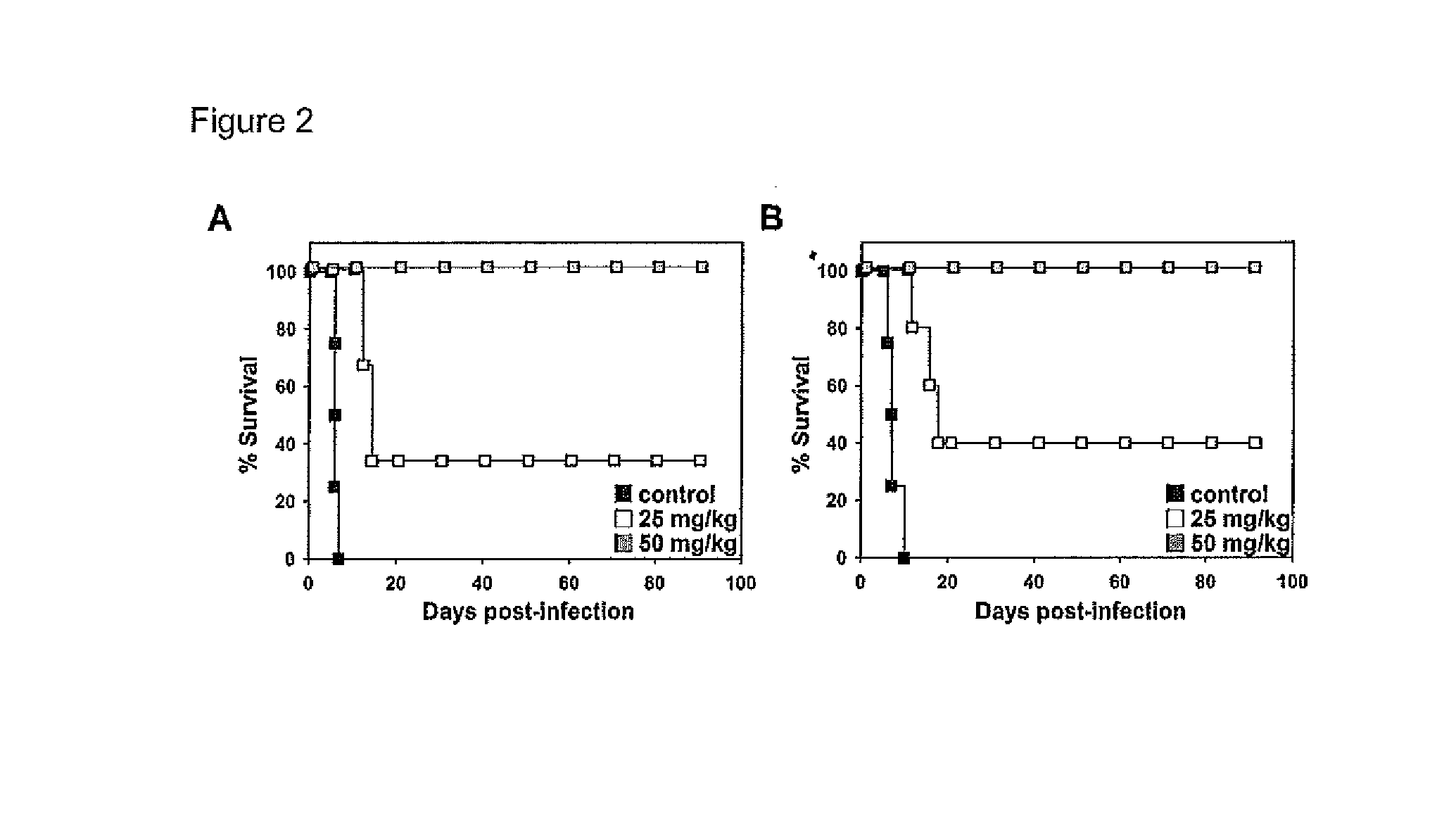New pradimicin derivatives for the treatment of diseases caused by kinetoplastids
a technology of kinetoplastids and derivatives, which is applied in the direction of antiparasitic agents, drug compositions, medical preparations, etc., can solve the problems of reactive encephalopathy (encephalopathy syndrome), more toxic second-stage drugs, and the possibility of death
- Summary
- Abstract
- Description
- Claims
- Application Information
AI Technical Summary
Benefits of technology
Problems solved by technology
Method used
Image
Examples
example 1
Activity In Vitro of PRM-S, PRM-A, PRM-FS and FA1-Mono Sugar Against T. brucei
[0097]The non-peptidic CBAs, PRM-A and PRM-S (FIG. 1) are active in vitro in the low micromolar range against Trypanosoma brucei brucei as can be seen in Table 1.
TABLE 1EC50 values for prokaryote-derived CBAs against T. brucei BSF.CBASpecificityEC50 (μg · mL−1)EC50 (μM)PRM-Sα(1,2) Man5.85 ± 0.086.44 ± 0.08PRM-Aα (1,2) Man3.20 ± 0.043.80 ± 0.05PRM-FSα (1,2) Man13.0 ± 0.7 13.5 ± 0.8 FA1-mono sugarα (1,2) Man24.3 ± 2.1 33.3 ± 2.8
example 2
Activity In Vivo of PRM-S Against T. brucei
[0098]In order to establish the trypanocidal capacity of PRM-S, C57BL / 6J or BALB / c mice were infected with T. b. brucei 427 or T. b. rhodesiense EATRO3 strains, respectively, and infection was allowed to proceed for 3 days before treatment with PRM-S, one dosage per day for 4 days.
[0099]In the case of C57BL / 6J mice infected with T. b. brucei, untreated mice died between the 6th and 7th day post-infection when parasitaemia reached around 1×109 cells*mL−1, thus a mean survival day (MSD) of 6.25±0.5 was obtained (FIG. 2A). In contrast, PRM-S administration starting at the 3rd day post-infection, when parasitaemia reached 1×107 cells·mL−1, resulted in a dramatic decrease of parasitaemia after the first dose of 50 mg·kg−1, or after the third dose of 25 mg·kg−1, even after reaching a high parasite concentration. However, parasitaemia was resumed in mice treated with 25 mg·kg−1, exhibiting a mean relapse day (MRD) of 10.7±0.6. The MSD for 25 mg·k...
example 3
Activity In Vitro of P-RM-S and PRM-A Against L. donovani and T. cruzi
[0101]As can be seen in Tables 3 and 4, the non-peptidic carbohydrate binding agents PRM-S and PRM-A are active against different stages of T. cruzi and L. donovani parasites cultured in vitro. Pradimicin-S and pradimicin-A were active at low micromolar concentrations against amastigotes of Leishmania donovani, the intracellular stage of the parasite present in the human host and they were also active against L. donovani promastigotes. No toxicity was observed in macrophages (EC50>100 μM). In addition, both derivatives induce lysis at low micromolar concentrations of trypomastigote forms of Trypanosoma cruzi, the infective stage responsible for invasion of mammalian host cells (Table 4).
TABLE 3PRM-S and PRM-A activity against L. donovani.Cell lineCBAspecificityEC50 (μg · mL−1)EC50 (μM)L. donovaniPRM-Aα(1,2) Man18.0 ± 0.721.4 ± 0.8promastigotesPRM-Sα(1,2) Man21.8 ± 1.922.9 ± 1.9PRM-Fsα(1,2) Man49.1 ± 2.050.8 ± 2.1...
PUM
 Login to View More
Login to View More Abstract
Description
Claims
Application Information
 Login to View More
Login to View More - R&D
- Intellectual Property
- Life Sciences
- Materials
- Tech Scout
- Unparalleled Data Quality
- Higher Quality Content
- 60% Fewer Hallucinations
Browse by: Latest US Patents, China's latest patents, Technical Efficacy Thesaurus, Application Domain, Technology Topic, Popular Technical Reports.
© 2025 PatSnap. All rights reserved.Legal|Privacy policy|Modern Slavery Act Transparency Statement|Sitemap|About US| Contact US: help@patsnap.com



